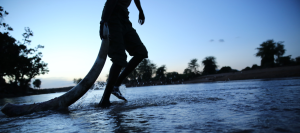Cold War Radioactivity Helps Fight Trade in Illegal Elephant Ivory

PHOTO CREDIT: © SEAN DUNDAS
Press Release
A new method for dating elephant tusks has been established that is expected to make it easier to enforce the current worldwide ban on ivory.
The study, by scientists from Colombia University, the University of Arizona, Save the Elephants and the Kenya Wildlife Service, is published this week in the Proceedings of the National Academy of Sciences (PNAS).
Elephant tusks grow ring by ring and the ivory records what plants the animals ate. While photosynthesizing, all plants absorb radioactivity from the air that was put there by nuclear weapons testing in the 1950s and 1960s. This gives scientists a time marker for all those meals.
The radiocarbon travels up the food chain, finding its way into the fingernails, hair, teeth and tusks of herbivores. By comparing radiocarbon levels in those tissues against the ever-diminishing amount of radiocarbon in the atmosphere – the “bomb curve” – forensic scientists can pinpoint when the tissue formed, and in some cases, when the animal died.
Over the years, poaching and wildlife trade has become one of the world’s worst crimes, among the world’s top five illegal activities after drugs, human trafficking, counterfeiting and arms.
Presently, an estimated 30,000 elephants are slaughtered annually, driven in part by the lack of a reliable way of distinguishing between legal pre-1989 ivory and illegal post-ban ivory.
“We’ve developed a tool that allows us to determine the age of a tusk or piece of ivory, and this tells us whether it was acquired legally,” said the study’s lead Author, Kevin Uno “Our dating method is affordable for government and law enforcement agencies and can help tackle the poaching and illegal trade crises.”
Incidents across Africa give detail to the statistics concerning the illegal killing of elephants. In May 2013, a group of armed poachers impersonated members of the Central African Republic’s transitional government force and slaughtered 26 elephants at Dzanga Bai, a UNESCO World Heritage Site. Save the Elephants has lost several of its study elephants to poachers.
Save the Elephants is proud to be involved in this landmark study and hopes to see the technique eventually included in the routine analysis of seized ivory to better ascertain its source.
The National Science Foundation, the National Geographic Society and the University of Utah funded the ‘Bomb Curve Aging’ study authored by Kevin Uno, a Postdoctoral Researcher at Columbia University’s Lamont-Doherty Earth Observatory and co-authored by George Wittemyer, Save the Elephant’s Head of Scientific board, Jay Quade, University of Arizona; Daniel Fisher, Iain Douglas-Hamilton, CEO and Founder Save the Elephants; Samuel Andanje, Patrick Omondi and Moses Litoroh, all of the Kenya Wildlife Service.

